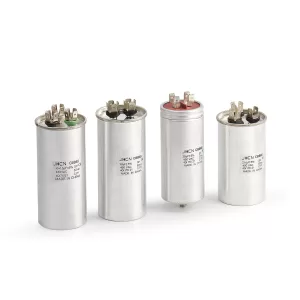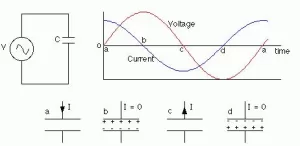
Unveiling AC Capacitor: What is an AC Capacitor and How Does It Work?
October 23 2023  1389
1389
Inquiry
Global electronic component supplier AMPHEO PTY LTD: Rich inventory for one-stop shopping. Inquire easily, and receive fast, customized solutions and quotes.
QUICK RFQ
ADD TO RFQ LIST
In many electrical systems, including air conditioners, AC capacitors are a crucial component. They are essential in maintaining voltage stability and energy storage, which keeps these devices functioning smoothly and effectively. In this blog, we will discuss what an AC capacitor is, how it works, and some of the most common AC capacitor symptoms and solutions. We will also cover how to test and replace an AC capacitor.
What is an AC Capacitor?
An AC capacitor is a two-terminal electrical component that stores energy in an electric field. It is composed of two conductive plates separated by a dielectric substance like paper, plastic, or film. The electric field between the capacitor plates creates a deficiency of electrons on the other plate when an AC voltage is supplied, which causes electrons to collect on one plate. A potential difference between the plates is produced as a result, and this potential difference is stored as energy in the electric field.
What Does an AC Capacitor Do?
AC capacitors have a variety of applications in electrical circuits. They are commonly used to:- Energy storage: Energy can be temporarily stored using AC capacitors. Applications like power factor adjustment and signal noise filtering can both benefit from this.
- Regulate voltage: By absorbing or releasing energy from the circuit as necessary, AC capacitors can be utilized to regulate voltage. Voltage spikes and dips, which can harm electrical equipment, can be avoided in this way.
- Signal filtering: By obstructing high-frequency currents, AC capacitors can be used to filter out noise from transmissions. For enhancing the caliber of audio and video transmissions, this can be helpful.
How Does an AC Capacitor Work?

- When an AC capacitor is connected to an AC circuit, the voltage across the capacitor alternates.
- When the voltage is positive, electrons are drawn to the capacitor's positive plate while being repelled by its negative plate. As a result, the dielectric substance is subject to an electric field.
- The opposite happens when the voltage is negative. Electrons are drawn to the negative plate and repelled by the positive plate. The electric field's direction is changed as a result.
- The electrons cannot go from one plate to the other due to the electric field present across the dielectric substance. Thus, the capacitor is a storage device for electrical energy.
- A capacitor's capacitance determines how much electrical energy it can hold. In farads (F), capacitance is expressed. More electrical energy can be stored in a capacitor by increasing its capacitance.
- Up until the voltage across the capacitor matches the voltage across the AC source, it will charge.
- The capacitor will begin to dissipate after it has reached its full charging capacity. Up until a voltage of zero is applied across the capacitor, it will discharge.
- The process will then be repeated while the capacitor is charging in the opposite way.
Video related to how Capacitors work in AC
AC capacitors in air conditioners
For an air conditioner to work, AC capacitors are necessary. They are employed to activate and maintain the compressor's motor. The capacitor starts the compressor motor when the air conditioner is turned on by sending a surge of current across it. The capacitor gives the motor a constant stream of current once it is operating, keeping it going.How to Test an AC Capacitor?
There are two main ways to test an AC capacitor:- Using a capacitor tester: A tester for capacitors is a tool that gauges their capacitance. Simply connect the tester to the capacitor's terminals to test an AC capacitor, then check the capacitance measurement.
- Using a megohmmeter: A megohmmeter is a tool that assesses a capacitor's insulating resistance. Simply attach a megohmmeter to the capacitor's terminals and examine the insulation resistance value to test an AC capacitor.
How to Replace an AC Capacitor?
To replace an AC capacitor, follow these steps:- Cut off the air conditioner's power.
- If necessary, discharge the capacitor. Use a screwdriver to connect the capacitor's terminals in a short circuit to do this.
- Detach the outdated capacitor.
- Put in the fresh capacitor.
- The air conditioner should be powered on after being connected.
How to Discharge an AC Capacitor?
- Cut off the air conditioner's power.
- To reveal the capacitor, remove the air conditioner's cover.
- With a screwdriver, touch the capacitor's terminals together. As a result, a spark will be produced, discharging the capacitor.
- Reattach the power after replacing the air conditioner's cover.
How Long Does an AC Capacitor Last?
An AC (alternating current) capacitor's lifespan can vary based on a number of variables, including usage, operating circumstances, and the capacitor's quality. Capacitors for AC systems typically have a lifespan of 10 to 20 years. However, it's important to note that there are factors that can affect the lifespan of an AC capacitor and potentially shorten it. Some of these factors include:- Operating temperature: A capacitor's lifespan can be shortened and its aging process accelerated by high temperatures. Capacitor lifespans may be shortened in AC units operating in hot areas or those exposed to intense heat.
- Voltage stress: Excessive voltage levels can stress the capacitor, resulting in early failure. Voltage spikes or variations above the rated voltage of the capacitor may shorten its lifespan.
- Electrical stress: A capacitor's lifespan can be impacted by sudden voltage changes and electrical surges. The capacitor may become more stressed if the electrical system frequently experiences power surges or variations.
- Quality of the capacitor: The capacitor's lifespan may be influenced by how well it was manufactured. Capacitors of higher quality that are designed to endure challenging environments and voltage swings may last longer than those of lesser quality.
Where to Buy an AC Capacitor?
Finding the Right AC Capacitor Supplier It's crucial to get an AC capacitor from a reliable vendor. This will make it more likely that the capacitor will be high-quality and durable. Top Places to Buy an AC Capacitor Some of the top places to buy an AC capacitor include:- Online retailers: A lot of online merchants sell AC capacitors. Among the most well-known merchants are Amazon, eBay, and Home Depot.
- HVAC supply stores: AC capacitors are available from HVAC supply businesses, which also sell other HVAC parts.
- Hardware stores: AC capacitors are available in some hardware stores. To make sure they have the sort of capacitor you require, it is crucial to call the shop ahead of time before making a purchase.
How to Tell if an AC Capacitor is Bad?
A faulty AC capacitor can be detected in a few different ways. Searching for outward indications of failure, such as bulges, cracks, or leaks, is one method. A multimeter can also be used to check the capacitor's capacitance. The capacitor is probably damaged if the capacitance reading is much lower than the rated capacitance.AC capacitor Symptoms
If the AC capacitor in your air conditioner fails, it can cause a variety of problems, including:- Humming noises: A failed capacitor may be audible when the air conditioner is running.
- Slow starting or stopping: A malfunctioning capacitor may be the cause of the air conditioner's slow starting or halting.
- Frequent cycling: If the air conditioner repeatedly comes on and goes off, there may be a malfunctioning capacitor.
- Reduced cooling capacity: A failed capacitor may be the cause of the air conditioner's decreased cooling capability.
How Much is an AC Capacitor?
The price of an AC capacitor can vary depending on a number of factors, including the type of capacitor, its capacitance, and the brand. However, most AC capacitors cost between $8 and $45. Here is a breakdown of the average prices of different types of AC capacitors:- Start capacitor: $9-$25
- Run capacitor: $8-$30
- Dual capacitor: $15-$45
- Blower capacitor: $9-$15
- Heat pump capacitor: $15-$45
Common AC Capacitor Issues and Solutions
AC capacitors are essential components of air conditioning systems, but they can fail over time. Some common AC capacitor issues include:- Overheating: If AC capacitors are not adequately vented or if dust and debris accumulate on the parts, they may overheat. The capacitor may fail early due to overheating.
- Lightning strikes and power surges: Lightning strikes and power surges can harm AC capacitors and lead to their failure.
- Age: The lifespan of an AC capacitor is between 5 and 10 years. They might begin to falter after this point.
- No cold air is being released by the air conditioner
- Very high energy costs
- Unsteady humming
- A dated HVAC system
- Automatic shut-off of the air conditioner
- Not quickly starting in the air conditioner
- Unable to switch on the air conditioner
How to Troubleshoot AC Capacitor Problems?
If you are experiencing problems with your air conditioner, it is important to troubleshoot the issue to determine if the capacitor is the cause. To troubleshoot AC capacitor problems, you can follow these steps:- Look for physical indications of failure on the capacitor, such as bulges, cracks, or leaks.
- Using a multimeter, check the capacitor's capacitance.
- Replace the capacitor with a new one if it is discovered to be defective.
Conclusion
In conclusion, AC capacitors are essential to the efficient operation of air conditioning systems. You can maintain the effectiveness and durability of your air conditioning equipment by being aware of its function, potential failure signs, testing techniques, and replacement procedures. If you are having issues with your air conditioner, it's crucial to do a thorough investigation to see if the capacitor is to blame. It is crucial to swap out the capacitor with a new one if it is discovered to be defective.Populer Posts
5SGXMA5N1F45I2G
Intel
LCMXO2-2000HE-6MG132I
Lattice Semiconductor Corporation
A1010B-1PG84M
Actel
5CGXBC4C6F27C7N
Intel
5SGXEA9K1H40C2LG
Intel
UCD7242RSJR
Texas Instruments
M1A3P600L-1FG256
Microsemi Corporation
5SGSMD4H3F35I4G
Intel
OR3T556PS240-DB
Lattice Semiconductor Corporation
1ST110EN2F43E2LG
Intel
5SGXEA7N2F40I3LG
Intel
A1240A-PQG144C
Microsemi Corporation
